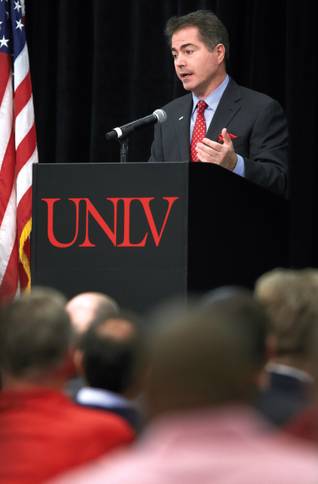
New UNLV president Len Jessup held a Campus Town Hall on March 12, revealing his plans for the university and fielding questions from students, faculty, staff and community members.
Friday, Oct. 16, 2015 | 2 a.m.
It’s not easy landing a place among the nation’s top research universities, but UNLV is trying to get there.
You may have heard about the UNLV’s long-running effort to achieve the Carnegie Foundation’s Tier-One designation, reserved for an elite group of American research universities.
But achieving Tier-One status isn’t UNLV’s sole goal anymore. Last month UNLV President Len Jessup outlined a vision for becoming a “Top-Tier” institution, which includes the Carnegie ranking as well as making sure the university improves on a list of other actions, like improving graduation rates and student satisfaction.
“We quickly realized that if we (pursued Tier-One) and didn’t do the other things, we were missing out on opportunities for UNLV,” said Nancy Rapoport, executive vice president and provost.
“When you look at really great research universities, they provide an extraordinary education for their students,” she added.
So what does UNLV need to do be Top Tier? There are many factors; but here are a few of the key ones:
Goal: Research expenditures reach $150 million a year by 2025
Where UNLV is: $39 million a year
This is the big one, mostly because of how far UNLV has to go to reach the goal. Currently, research expenditures at the university hover around $39 million a year. That’s significantly under the goal of $150 million, which is ambitious when you compare it to how much other universities classified as Tier-One spend on research. UNLV’s goal would put it well above that of even the University of Houston or the University of Oregon. You would think UNLV has slowly increased its research expenditures, but the Great Recession caused a sharp drop-off. In 2007, research expenditures at UNLV were $54 million. While they tanked shortly after, they are on the rise again.
Goal: Doctoral degrees awarded reach at least 200 per year by 2025
Where UNLV is: 91 per year
As with research spending, the amount of doctorates annually awarded by a university is a good indicator of how well an institution is doing when it comes to research. UNLV’s goal of 200 doctorates conferred every year is not unrealistic. The idea is to award around 100 per year starting in 2015 — not that far off the current mark. Of course, UNLV still trails research behemoths like Arizona State University, which awards about 580 doctoral degrees annually.
Goal: The UNLV medical school gains full accreditation by 2022
Where UNLV is: The medical school still in development, and the accreditation process is ongoing
Planning dean Dr. Barbara Atkinson and her team have been working since 2014 to get the proposed UNLV medical school up and running by 2017. If their progress so far is any indication, they’ll have no trouble meeting the goal.
But getting the school accredited is a little harder.
Medical schools need accreditation to be seen as reputable, but the process takes years to complete. Atkinson will have to show members of the Liaison Committee on Medical Education, in a series of exacting reviews and campus visits, that the medical program meets a lengthy list of standards. The university hopes the med school will achieve preliminary accreditation in 2016, followed by provisional accreditation in 2019 before becoming fully accredited in 2022.
Goal: Retention rate of 85 percent of first-year students by 2025
Where UNLV is: 74 percent
This one is more in line with Jessup’s vision of becoming a Top-Tier public institution, and it is a good indicator of how the university is doing when it comes to student services like advising. UNLV is not that far off the mark. Currently, the university retains around 74 percent of freshmen after their first year. The problem is that number has stayed relatively the same for years, and, in fact, dropped slightly this year. A related goal is to improve UNLV’s graduation rate of around 40 percent, which has long been a sore spot for the university.
Goal: Produce 9 patents per year by 2025
Where UNLV is: 1 patent per year
The amount of patent applications filed by the university has tripled in recent years. Last year UNLV filed 45 of them. That’s good, though not every application is destined to make it through the lengthy process to winning a patent. As a result, it tends to take awhile for actual patents to trickle in, which is why UNLV only has one to report right now. The average patents issued per year at other Tier-One research universities is around 12, according to UNLV. Most of the applications filed by the university have to do with science, engineering and gaming technologies.
Goal: 80 percent student satisfaction by 2023
Where UNLV is: 71 percent
Another of Jessup’s goals is to make UNLV a more well-rounded university. Currently, 71 percent of UNLV students report being satisfied with the university’s services and instruction. It’s not a requirement for achieving Tier-One status, but it could lead to a boost for UNLV’s reputation in the eyes of students, which could lead to higher enrollment down the road. The university gauges student opinion through the Student Satisfaction Inventory, which is a survey conducted every three years with the help of Noel-Levitz, a national higher education consulting firm.

Join the Discussion:
Check this out for a full explanation of our conversion to the LiveFyre commenting system and instructions on how to sign up for an account.
Full comments policy